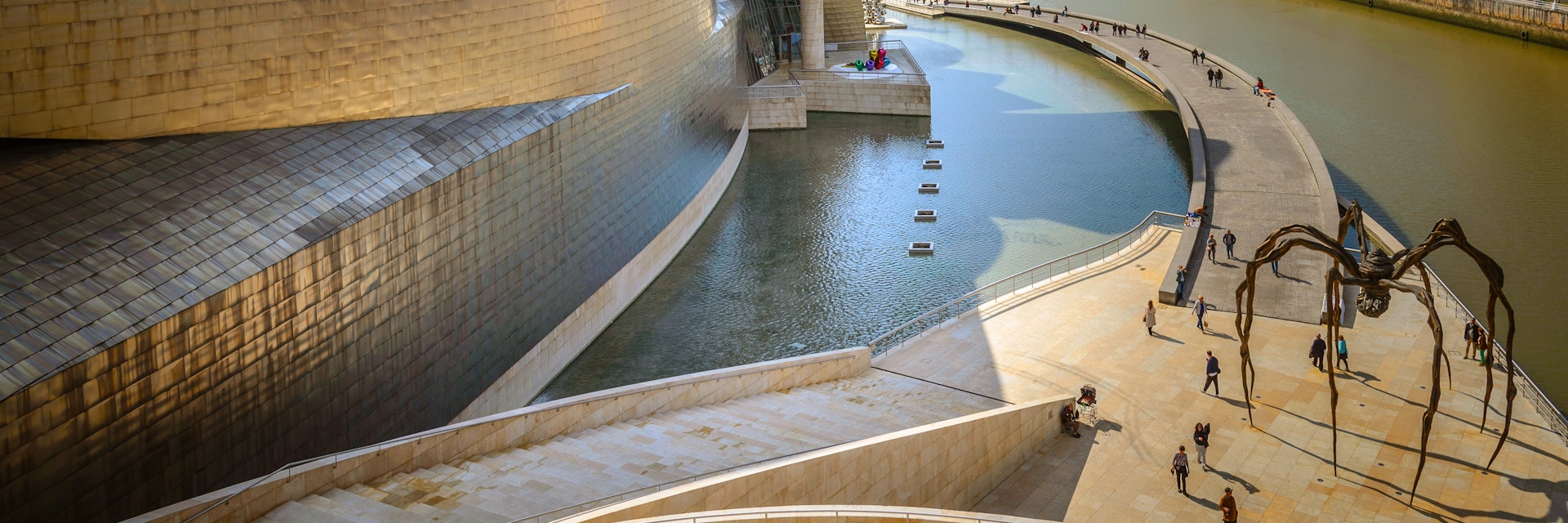Shimmering titanium Museo Guggenheim Bilbao is one of modern architecture's most iconic buildings. It played a major role in helping to lift Bilbao out of its postindustrial depression and into the 21st century ÔÇô and with sensation. It sparked the cityÔÇÖs inspired regeneration, stimulated further development and placed Bilbao firmly in the international art and tourism spotlight.
Some might say that structure overwhelms function here and that the museum is more famous for its architecture than its content. But Canadian architect Frank GehryÔÇÖs inspired use of flowing canopies, cliffs, promontories, ship shapes, towers and flying fins is irresistible.
Gehry designed the museum with historical and geographical contexts in mind. The site was an industrial wasteland, part of BilbaoÔÇÖs wretched and decaying warehouse district on the banks of the R├¡a del Nervi├│n. The cityÔÇÖs historical industries of shipbuilding and fishing reflected GehryÔÇÖs own interests, not least his engagement with industrial materials in previous works. The titanium tiles that sheathe most of the building like giant herring scales are said to have been inspired by the architectÔÇÖs childhood fascination with fish.
Other artists have added their touch as well. Lying between the glass buttresses of the central atrium and the R├¡a del Nervi├│n is an installation by Fujiko Nakaya: a simple pool of water that emits a mist. Near the riverbank is Louise Bourgeois' Maman, a skeletal spider-like canopy said to symbolise a protective embrace. In the open area west of the museum, the child-favourite fountain sculpture randomly fires off jets of water. Jeff KoonsÔÇÖ kitsch whimsy Puppy, a 12m-tall highland terrier made up of thousands of begonias, is on the city side of the museum. Bilbao has hung on to ÔÇİEl PoopÔÇÖ, who was supposed to be a passing attraction as part of a world tour. Á■¥▒▒¶▓·▓╣├¡▓È┤Ã▓§ will tell you that El Poop came first ÔÇô and then they had to build a kennel behind it.
Heading inside, the interior is purposefully vast. The cathedral-like atrium is more than 45m high, with light pouring in through the glass cliffs. Permanent exhibitions fill the ground floor, including Richard Serra's massive maze-like sculptures in weathered steel and, reaching for the skies, Jenny Holzer's nine LED columns of ever-flowing phrases and text fragments (in English, Spanish and Basque).
For many people, it is the temporary shows ÔÇô from retrospectives of the groundbreaking contemporary video artist Bill Viola to wide-ranging exhibitions on fin de si├¿cle Paris ÔÇô that are the main attraction. Excellent self-guided audio tours in various languages are free with admission and there is a special children's audio guide.
Free guided tours in Spanish take place at 5.45pm and 6.30pm; sign up half an hour before at the information desk. Tours can be conducted in other languages but you must ask at the information desk beforehand. Groups are limited to 20 (and there needs to be a minimum of eight), so get there early. ItÔÇÖs also possible to organise private group tours in Spanish, English, French and German, among other languages, by prior arrangement.
The museum is equipped with specially adapted magnetic loop PDA video guides for those with hearing impairments, and is wheelchair accessible.
Entry queues can be horrendous, particularly on wet summer days and during holidays such as Easter; in busy times, you're best prebooking online with an allocated time slot.
